ISO14001:2015 新版标准正式发布
SO140012015新版标准
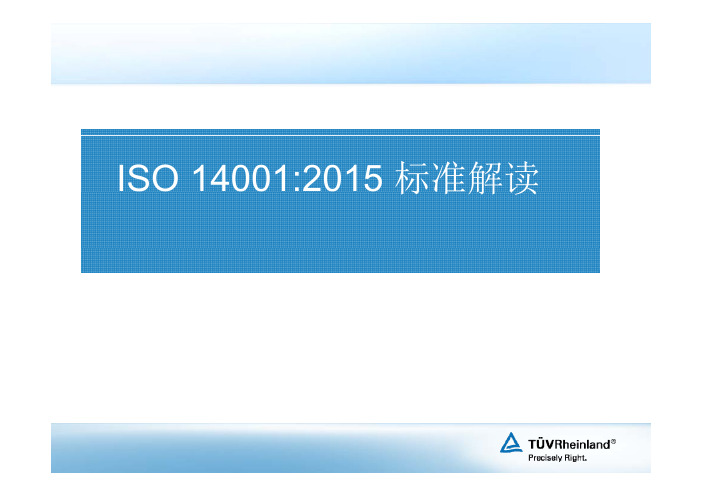
ISO 14001:2015 标准解读目录1. ISO 14001产生背景及标准改版计划1ISO1400122. 重大改变33. 新版标准条款结构44. 主要条款解读及应对措施5. 实施ISO 14001常见问题ISO 14001 Certification Asia18世纪兴起的工业革命,曾经带给人18世纪兴起的工业革命曾经带给人类无限希望和欣喜,工业化兴起、城市化发展、科学技术的进步使人类的市发科学技术步类,生活水平得到飞速提高,人类文明进入到一个新的高度。
然而,工业革命给人类带来的不仅是然而工业革命给人类带来的不仅是欣喜,还有诸多意想不到的后果,甚至埋下了人类生存和发展的潜在威胁至埋下了人类生存和发展的潜在威胁。
ISO 14001 Certification Asia我们面临的环境问题ISO 14001 Certification Asia导致的结果▪自然环境的恶化▪污染▪生物多样性的减少▪相关方环境意识的提高▪顾客▪投资者▪员工▪政府部门要求▪邻居▪可持续发展的需要ISO 14001 Certification Asia环境管理发展的必然趋势污染→→源头管制未端治理→系统管理ISO 14001 Certification Asia为什么要推行ISO 14001?14001提供了一个科学,系统的管理方法帮助企业主动的识别各种实际或潜在的环境风险;科学的评估该风险的高低和确定控制的优先级别;系统采取措施对该风险进行全面的控制与管理; 持续的改进过程的环境绩效;相关的境险降低相关的环境风险;ISO 14001 Certification Asia满足组织或相关方对环境的期望和要求。
ISO 14001的好处▪1. 满足直接客户/间接客户的业务评估要求,提升客户信心;▪2. 有利于企业参与国际竞争,突破贸易壁垒;3作为自身内部管理的手段提高环境管理的▪3. 作为自身内部管理的手段,提高环境管理的绩效, 减少废气/废水/噪音/危险废弃物的排放, 提高能源/资源的使用效率,降低企业的排放,提高能源/资源的使用效率,降低企业的生产成本,提升企业的竞争力;实施,以持续满足有关的环保▪4. 通过实施EMS,可以持续满足企业有关的环保法律法规要求,规避或降低违法的风险,实现可持续发展,提升企业环保的社会形象,赢得客户/政府/工业区/员工的青睐和认可;ISO 14001 Certification AsiaISO 14001改版的目的▪在接下来的10年或更长时间,提供一套稳定的精炼的要求。
ISO 14001:2015标准最新版
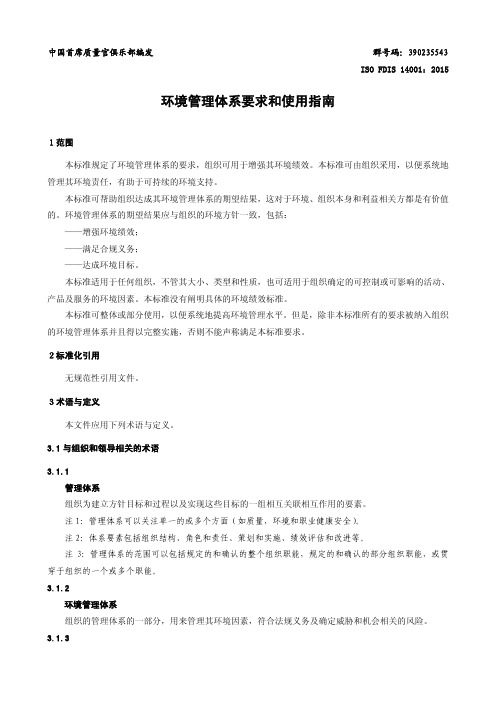
如设计、制造、运输、包装和最终利用和处置。 3.3.4
外包 对外部组织执行组织的职能或过程的一部分做出的安排。 注 1:外部组织处于管理体系的范围以外,尽管外包的职能或过程仍属于组织的范围内。 3.3.5 过程 一组将输入转换为输出的相互关联或相互作用的活动。 注 1:过程可以形成文件或不形成文件。
纠正措施
为消除一个不符合的原因并防止其再发生所采取的行动。
注 1:对一项不符合,可以存在多个原因。
3.4.5
持续改进
增强绩效的反复的活动。
注 1:强化环境管理体系的使用效果是为了提高环境绩效符合组织的环境方针。
注 2:该活动不必同时发生在所有领域或不间断地发生。
3.4.6
有效性
实现了策划的活动和策划的结果的程度。
5.1 领导作用和承诺
最高管理者应通过以下方式表现出对于环境管理体系的领导作用与承诺: a) 为环境管理体系的有效性负责; b) 保证环境方针及环境目标的建立并且它们是与组织的战略方向和组织背景一致; c) 保证环境管理体系的要求与组织的运营过程相融合; d) 提供环境管理体系所需的资源; e) 传递有效的环境管理和遵守环境管理体系要求的重要性; f) 保证环境管理体系实现其预期的结果; g) 指导及支持有助于环境管理体系有效性的人员; h) 推动持续改进; i) 支持其他相关管理岗位的管理者在其职责范围内的领导作用。 注:此国际标准中指出的“运营”可以慨括的理解为组织存在的核心活动。
注 1:污染预防可包括源削减或消除,过程,产品或服务的更改,资源的有效利用,材料或能源替代,
ISO14001-2015标准讲解(最新修正版)
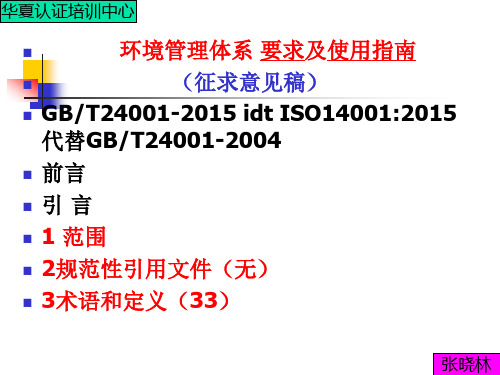
4、组织所处的环境(10) 5、领导作用(13) 6、策划(18) 7、支持(20) 8、运行(8) 9、绩效评价(17) 10、改进(5)
张晓林
华夏认证培训中心
4组织所处的环境(10) 4.1理解组织及其所处的环境(1) 4.2理解相关方的需求和期望(3) 4.3确定环境管理体系的范围(4) 4.4环境管理体系(2)
张晓林
华夏认证培训中心
hall(应)”表示要求; ——“should(应当)”表示建议; ——“may(可以)”表示允许; ——“can(可能、能够)”表示可能性或能 力。 标记“注”的信息旨在帮助理解或使用本文件。 第3章使用的“注”提供了关于补充术语信息 的附加信息,可能包括使用术语的相关规定。 第3章中的术语和定义按照概念顺序进行编排, 本文件最后还给出了按字母顺序的索引。
3.1.6 相关方 interested party 能够影响决策或活动、受决策或活动影响,或感觉 自身受到决策或活动影响的个人或组织(3.1.4)。
示例:相关方可包括顾客、社区、供方、监管部门、非政府 组织、投资方和员工。 注1:“感觉自身受到影响”意指组织已知晓这种感觉。 张晓林
华夏认证培训中心
张晓林
华夏认证培训中心
环境管理体系 要求及使用指南
1 范围 本标准规定了组织能够用来提升其环境绩效的环 境管理体系要求。本标准可供寻求以系统的方式 管理其环境责任的组织使用,从而为可持续发展 的“环境支柱”做出贡献。 本标准可帮助组织实现其环境管理体系的预期结 果,这些结果将为环境、组织自身和相关方带来 价值。与组织的环境方针保持一致的环境管理体 系预期结果包括: ——提升环境绩效; ——履行合规义务; ——实现环境目标。
完整版ISO14001-2015环境管理体系
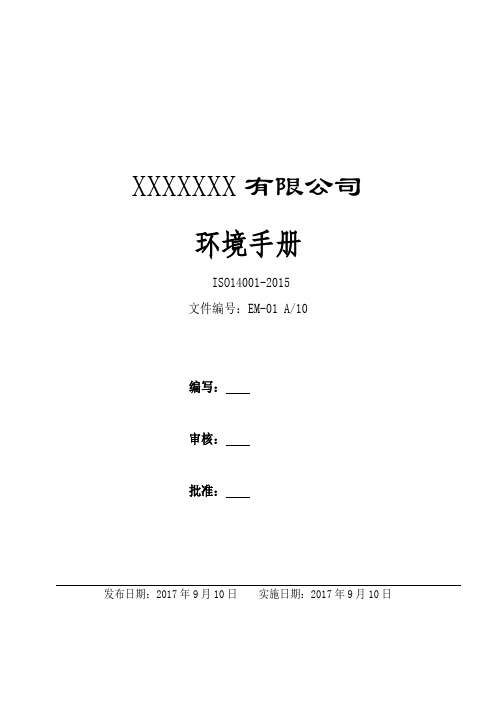
XXXXXXX有限公司环境手册ISO14001-2015文件编号:EM-01 A/10编写:审核:批准:发布日期:2017年9月10日实施日期:2017年9月10日修订记录目录第1 章概述1.1 颁布令1.2 公司简介1.3 管理者代表任命书1.4 环境手册的管理第2章管理体系范围第3章手册引用文件、术语和定义3.1 引用标准文件3.2 术语和定义第4章组织的背景4.1理解组织及其所处的环境4.2 理解相关方的需求和期望4.3确定管理体系的范围4.4管理体系及其过程第5章领导作用5.1 领导和承诺5.2 环境方针5.3 组织的岗位、职责和权限第6章质量环境管理体系策划6.1 应对风险和机遇的措施6.1.1 总则6.1.2 环境因素6.1.3 合规义务6.1.4 措施的策划6.2 环境目标及其实现策划6.2.1 环境目标6.2.2 实现环境目标措施的策划第7章支持7.1 资源7.2 能力7.3 意识7.4 信息交流7.4.1 总则7.4.2 内部信息交流7.4.3 外部信息交流7.5 文件信息7.5.1 总则7.5.2 创建和更新7.5.3 文件信息控制第8章运作8.1 运行策划和控制8.2 应急准备和响应第9章绩效评价9.1 监视、测量、分析和评价9.1.1 总则9.1.2 合规性评价9.2 内部审核9.2.1 总则9.2.2 内部审核方案9.3 管理评审第10章改进10.1 总则10.2 不符合和纠正措施10.3 持续改进1.1环境手册颁布令环境手册是本公司从事与环境管理有关的活动中必须共同遵守的纲领性文件,是公司的基本法规之一,必须严格遵守,以确保公司环境管理体系的正常运行,实现质量环境管理目标,促使公司环境管理工作得到持续改进与不断发展。
环境手册由管理者代表负责组织编写、并经总经理批准发布,是我公司环境管理工作的法规性、纲领性文件,用以统一、协调全公司的质量环境管理活动,使其基于ISO14001-2015标准要求,符合本公司产品、服务和活动中的实际情况,能指导我公司环境管理工作。
2015版ISO14001环境管理体系新标准的10大重要变化

2015版ISO14001环境管理体系新标准的10大重要变化发表时间:(2016-01-18 09:42:33)点击量:13142015年9月15日,备受关注的ISO 14001:2015环境管理体系标准最终版正式发布了。
这将对全球环境保护和环境管理起到划时代的意义。
这个新标准将有哪些重要的变化,这些变化有什么影响?ISO 14001是ISO 14000环境管理体系标准族中的龙头标准,由国际标准化组织发布,它是针对全球性的环境污染和生态破坏越来越严重,顺应国际环境保护的发展,依据国际经济贸易发展的需要而制定的。
标准明确指出:本标准的目的是为组织提供一个系统的框架,以保护环境和应对不断变化的环境条件与社会经济平衡的需求。
它是通过规范环境管理体系的要求,使组织能够提高环境绩效。
该标准自1996年首次发布以来,便受到世界各国和地区的普遍关注,至今,全球已有22000多家组织获得了ISO 14001标准认证,可以说,ISO 14001认证是通向未来国际贸易市场的绿色通行证。
ISO14001:2015版相较于ISO14001:2004版标准的10大重要变化:1“组织环境(Context of the organization)的意义”组织身处复杂的社会环境、文化环境、经营环境和自然环境中,受到各种环境的影响和制约,面临复杂环境下的风险和机遇,组织应清楚处于何种环境下和面对何种风险和机遇,以寻求保护环境和组织发展的平衡与和谐,更加务实。
2“生命周期思考(lifecycle thinking)”完整的生命周期需涵盖全球生态系统、上下数百年以及从自然资源到产品最终处置的全价值链,而组织作为一个很小的社会细胞,难以评价完整的生命周期,那么组织从哪里入手呢?组织应考虑在策划、实施、保持和改进过程中尽可能地延伸价值链以分析评价和施加影响,考虑其行为导致的环境负荷增减,降低环境负荷的上升或在实施保护环境的行为时追求和确保环境负荷的减少,防止本愿为保护环境,但实际效果却破坏了环境,尽可能以扩展时间、空间和价值链的角度,分析环境负荷的损益之后采取行动,切实达到保护环境的目的。
ISO14001:2015 新版标准正式发布
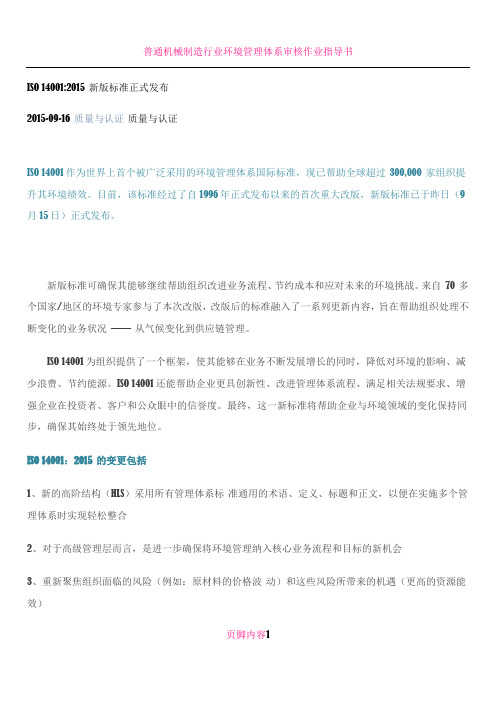
ISO 14001:2015 新版标准正式发布2015-09-16 质量与认证质量与认证ISO 14001作为世界上首个被广泛采用的环境管理体系国际标准,现已帮助全球超过300,000 家组织提升其环境绩效。
目前,该标准经过了自1996年正式发布以来的首次重大改版,新版标准已于昨日(9月15日)正式发布。
新版标准可确保其能够继续帮助组织改进业务流程、节约成本和应对未来的环境挑战。
来自70 多个国家/地区的环境专家参与了本次改版,改版后的标准融入了一系列更新内容,旨在帮助组织处理不断变化的业务状况——从气候变化到供应链管理。
ISO 14001为组织提供了一个框架,使其能够在业务不断发展增长的同时,降低对环境的影响、减少浪费、节约能源。
ISO 14001还能帮助企业更具创新性、改进管理体系流程、满足相关法规要求、增强企业在投资者、客户和公众眼中的信誉度。
最终,这一新标准将帮助企业与环境领域的变化保持同步,确保其始终处于领先地位。
ISO 14001:2015 的变更包括1、新的高阶结构(HLS)采用所有管理体系标准通用的术语、定义、标题和正文,以便在实施多个管理体系时实现轻松整合2、对于高级管理层而言,是进一步确保将环境管理纳入核心业务流程和目标的新机会3、重新聚焦组织面临的风险(例如:原材料的价格波动)和这些风险所带来的机遇(更高的资源能效)页脚内容14、对组织环境的新思考,帮助他们了解所处环境以及对环境的影响,同时还要了解环境问题(例如:气候变化)对企业自身的影响。
ISO 14001:2015标准换版时间轴1、2014年7月ISO 14001:2015 DIS版发布2、2014年12月ISO国际标准化组织正式投票通过ISO 14001:2015 DIS版,新标准进入FDIS阶段3、2015年4月ISO 14001:2015更新关键会议在英国召开,负责ISO 14001修订的ISO 技术委员会ISO/TC 207/WG 5 表示,他们在此次会议上朝着ISO 14001:2015的发布迈出了意义重大的一步。
ISO 14001:2015标准最新版

合规义务(见 6.1.3)可能产生风险和机会,如未能遵守(这可能损害本组织的声誉或导致法律行为的 结果)或履行超出其合规性的行为义务(可以提高组织的声誉)。
3.3.3 生命周期 产品系统的连续的相互关联的阶段,包括从原材料的获取或从自然界获取资源到产品的报废处理。 注 1:生命周期包括活动产品和服务,并且包括采购的商品和服务,以及产品和服务的报废处置,例
如设计、制造、运输、包装和最终利用和处置。 3.3.4
外包 对外部组织执行组织的职能或过程的一部分做出的安排。 注 1:外部组织处于管理体系的范围以外,尽管外包的职能或过程仍属于组织的范围内。 3.3.5 过程 一组将输入转换为输出的相互关联或相互作用的活动。 注 1:过程可以形成文件或不形成文件。
注 1:污染预防可包括源削减或消除,过程,产品或服务的更改,资源的有效利用,材料或能源替代,
再利用,回收,回收,回收和处理。
3.2.8
要求
陈述的需要或期望,通常是隐含的或必须的。
注 1:“通常隐含”意味着对于考虑需求或期望的组织和相关方的惯例或一般做法是隐含的。
注 2:特定的要求是一种陈述的要求,例如在文件化信息中规定的。
中国首席质量官俱乐部编发 4.4 环境管理体系
群号码:390235543
组织应依据本标准的要求建立、实施、保持并持续改进环境管理体系,包括所需要的过程及其相互作 用,以达成组织的预期结果,包括增强其环境绩效。
组织应在建立和维护环境管理体系时考虑在 4.1 和 4.2 条款中所获取的背景知识。
最新版ISO14001:2015标准解读

9
Quality Assurance Centre of China Association for Quality
三、GB/T24001-2015 讲解
0.2 环境管理体系的目的
本标准旨在为各组织提供框架,以保护环境,响应变化的环境状况,同
时与社会经济需求保持平衡。本标准规定了环境管理体系的要求,使组织
改进环境管理体系,对环境因素进行了有效控制,改善了环
境绩效,减少了环境影响,取得了显著的环境、经济和社会
效益。
实践表明,开展环境管理体系的建立、实施和认证工作,
对于组织提升企业形象、强化和提高环境管理水平、增强国
际竞争实力、实现污染预防、成本降低和持续改进等方面都
具有十分重要的意义。
中质协质量保证中心
改进环境管理体系,对环境因素进行了有效控制,改善了环
境绩效,减少了环境影响,取得了显著的环境、经济和社会
效益。
实践表明,开展环境管理体系的建立、实施和认证工作,
对于组织提升企业形象、强化和提高环境管理水平、增强国
际竞争实力、实现污染预防、成本降低和持续改进等方面都
具有十分重要的意义。
中质协质量保证中心
化为我国国家标准,从而更好地为我国的环境保护 和可持续发展提供标准化的技术支撑。
对GB/T24001-2004《环境管理体系 要求及使 用指南》国家标准的现有要求做出必要的保留与改
进,以期将新的环境管理方法和工具引入组织的环
境管理体系,满足日以高涨和严苛的相关方的需求
和期望。
中质协质量保证中心
6
Quality Assurance Centre of China Association for Quality
ISO14001-2015新版标准讲解2015

4.3 确定环境管理体系的范围 组织应确定EMS的边界及适用性,以确定其范围 。
在确定EMS范围时,应考虑:
a) 4.1中提到的内部和外部因素; b) 4.2中提到的合规性义务; c) 组织的单元、功能和物理边界;
d) 组织的活动、产品和服务;
e) 组织权限和行使控制及施加影响的能力。
一旦范围被界定,组织范围内的所有的活动、产 品和服务应包含在EMS范围内。
ቤተ መጻሕፍቲ ባይዱ12
过程管理
水消耗和 排放
大气排放
可持续发展
有害物质 危险废 弃物排放
模块化管理
噪声排放
13
5.1 领导作用与承诺 5.2 环境方针 5.3 组织的作用、职责和权限
3.1.5 最高管理者 top management 指挥和控制组织的最高层的人或团队。 注1:最高管理者有在组织内部授权和提供 资源的权力; 注2:如果管理体系的范围只覆盖了一个组 织的局部,则最高管理者只涉及指挥和控制 组织的这个局部的人。
范围应保留文件化信息,并可为相关方所获取。 11
4.4 环境管理体系
组织应按本标准的要求建立、实施、保持和持续改 进环境管理体系,包括所需要的过程及其相互作用 ,以达到包括增强其环境绩效在内的预期结果。
组织建立和保持其EMS时应考虑到4.1和4.2的背景 知识。
3.1.2 环境管理体系environmental management system 组织管理体系的一部分,用来管理其环境因素、履行合规 性义务、应对风险和机遇。 3.1.1 管理体系management system 一个组织建立方针、目标和过程并实现这些目标的相互关 联或相互作用的一组要素。
3.2.9 合规性义务 compliance obligation 法定要求和其他要求legal requirements and other requirements 组织必须要遵守的法定要求以及组织必须或选择要遵守的其他要求。
ISO14001-2015新版标准讲解

5. 领导作用
5.2 环境方针 最高管理者应在界定的的组织EMS范围内建立、实 施、保持方针: a)适合于组织的宗旨、环境,包括组织活动/产品/服务的性
质、规模和环境影响; b)提供建立目标的框架; c)包括对环境保护、污染预防和对组织特定情况下其他具体 环保承诺; d)包括对遵守合规义务的承诺; 注:其他具体环保 e)包括对持续改进EMS以提高环境绩效的承诺。 承诺可包括:资源 的可持续利用、减 方针应: 缓和适应气候变化、 -按文件化信息保留; 保护生物多样性和 生态系统。 -在组织内传达;
c) 化妆品包装盒丝印车间气味很大 d) 锅炉房内部噪声大
e) 生产区和非生产区中间设一个缓冲区确保没有交叉污染,保证生产区 洁净/厕所与车间之间应设缓冲区,并有防臭、防蚊蝇昆虫、通风排气等设施
2)外部存在的含义是什么? a) 外部存在从组织内延伸到全球系统,环境问题不能孤立的认为是一个 组织的问题,诸如大气污染(雾霾),海洋污染,臭氧层破坏等 b) 关注相关方(标准与相关方有关系)
6. 策划
6. 应对风险和机遇的措施
6.1.3 合规性义务 组织应: a)确定和获取与其环境因素有关的合规性义务要求; b)确定这些合规性义务要求如何应用于组织; c)建立、实施、保持、改进EMS时考虑合规性义务。 组织应保持合规性义务的形成文件的信息; 注:对组 织而言, 合规性义 务可导致 风险和机 遇。
a) 4.1中提到的内部和外部因素; b) 4.2中提到的合规性义务;
c) 组织的单元、功能和物理边界;
d) 组织的活动、产品和服务; e) 组织权限和行使控制及施加影响的能力。
一旦范围被界定,组织范围内的所有的活动、产 品和服务应包含在EMS范围内。
范围应保留文件化信息,并可为相关方所获取。 11
ISO-14001:2015版标准
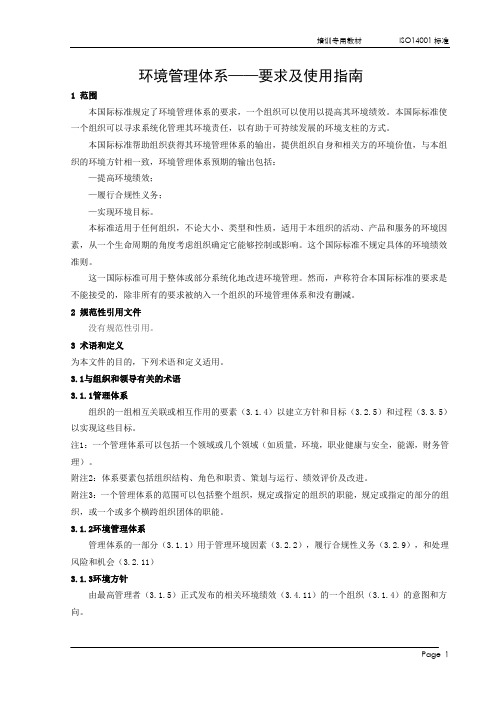
环境管理体系——要求及使用指南1 范围本国际标准规定了环境管理体系的要求,一个组织可以使用以提高其环境绩效。
本国际标准使一个组织可以寻求系统化管理其环境责任,以有助于可持续发展的环境支柱的方式。
本国际标准帮助组织获得其环境管理体系的输出,提供组织自身和相关方的环境价值,与本组织的环境方针相一致,环境管理体系预期的输出包括:—提高环境绩效;—履行合规性义务;—实现环境目标。
本标准适用于任何组织,不论大小、类型和性质,适用于本组织的活动、产品和服务的环境因素,从一个生命周期的角度考虑组织确定它能够控制或影响。
这个国际标准不规定具体的环境绩效准则。
这一国际标准可用于整体或部分系统化地改进环境管理。
然而,声称符合本国际标准的要求是不能接受的,除非所有的要求被纳入一个组织的环境管理体系和没有删减。
2 规范性引用文件没有规范性引用。
3 术语和定义为本文件的目的,下列术语和定义适用。
3.1与组织和领导有关的术语3.1.1管理体系组织的一组相互关联或相互作用的要素(3.1.4)以建立方针和目标(3.2.5)和过程(3.3.5)以实现这些目标。
注1:一个管理体系可以包括一个领域或几个领域(如质量,环境,职业健康与安全,能源,财务管理)。
附注2:体系要素包括组织结构、角色和职责、策划与运行、绩效评价及改进。
附注3:一个管理体系的范围可以包括整个组织,规定或指定的组织的职能,规定或指定的部分的组织,或一个或多个横跨组织团体的职能。
3.1.2环境管理体系管理体系的一部分(3.1.1)用于管理环境因素(3.2.2),履行合规性义务(3.2.9),和处理风险和机会(3.2.11)3.1.3环境方针由最高管理者(3.1.5)正式发布的相关环境绩效(3.4.11)的一个组织(3.1.4)的意图和方向。
3.1.4组织为了实现其目标(3.2.5)有自己的职能和职责、权限和关系的人或群体。
注1:组织的概念包括但不局限于单一的贸易商,公司,社团,企业,当权者,合伙企业,慈善机关或事业单位,或部分或组合,是否股份制或不是,公共的或私有的。
ISO14001 2015版标准
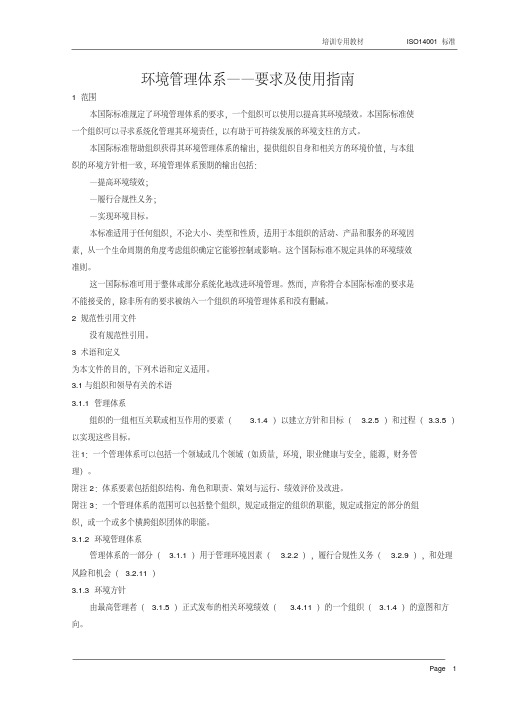
环境管理体系——要求及使用指南1 范围本国际标准规定了环境管理体系的要求,一个组织可以使用以提高其环境绩效。
本国际标准使一个组织可以寻求系统化管理其环境责任,以有助于可持续发展的环境支柱的方式。
本国际标准帮助组织获得其环境管理体系的输出,提供组织自身和相关方的环境价值,与本组织的环境方针相一致,环境管理体系预期的输出包括:—提高环境绩效;—履行合规性义务;—实现环境目标。
本标准适用于任何组织,不论大小、类型和性质,适用于本组织的活动、产品和服务的环境因素,从一个生命周期的角度考虑组织确定它能够控制或影响。
这个国际标准不规定具体的环境绩效准则。
这一国际标准可用于整体或部分系统化地改进环境管理。
然而,声称符合本国际标准的要求是不能接受的,除非所有的要求被纳入一个组织的环境管理体系和没有删减。
2 规范性引用文件没有规范性引用。
3 术语和定义为本文件的目的,下列术语和定义适用。
3.1与组织和领导有关的术语3.1.1管理体系组织的一组相互关联或相互作用的要素( 3.1.4)以建立方针和目标( 3.2.5)和过程( 3.3.5)以实现这些目标。
注1:一个管理体系可以包括一个领域或几个领域(如质量,环境,职业健康与安全,能源,财务管理)。
附注2:体系要素包括组织结构、角色和职责、策划与运行、绩效评价及改进。
附注3:一个管理体系的范围可以包括整个组织,规定或指定的组织的职能,规定或指定的部分的组织,或一个或多个横跨组织团体的职能。
3.1.2环境管理体系管理体系的一部分( 3.1.1)用于管理环境因素( 3.2.2),履行合规性义务( 3.2.9),和处理风险和机会( 3.2.11)3.1.3环境方针由最高管理者( 3.1.5)正式发布的相关环境绩效( 3.4.11)的一个组织( 3.1.4)的意图和方向。
3.1.4组织为了实现其目标( 3.2.5)有自己的职能和职责、权限和关系的人或群体。
注1:组织的概念包括但不局限于单一的贸易商,公司,社团,企业,当权者,合伙企业,慈善机关或事业单位,或部分或组合,是否股份制或不是,公共的或私有的。
ISO 140012015新版环境管理体系国际标准的十一大主要变化

ISO 14001:2015新版环境管理体系国际标准的十一大主要变化ISO 14001:2015新版标准正式向社会发布以来,不论在形式、结构还是内容上都有重大的改变,主要包括以下方面:1、标准结构上的变化ISO 14001:2015标准结构采用了HLS,除范围、规范性引用文件和术语外,标准正文包括7个条款:组织所处的环境、领导作用、策划、支持、运行、绩效评价、改进。
2、术语和定义上的变化ISO14001:2015版标准共有33个术语,相对于ISO 14001:2004版标准,除了术语“污染预防”没有任何变化外,其它都发生了变化。
3、提出战略环境管理的思维ISO 14001:2015版标准明确要求组织的环境管理体系应融入组织的战略过程的策划中。
ISO 14001:2015版标准中新增加的条款4.1(理解组织所处的环境)和4.2(理解相关方的需求和期望),要求从组织和环境两者的利益出发,识别并利用机遇,其中特别需要关注的是与相关方的需求(包括法规要求)和期望有关的事项或变化的环境,以及地区的、区域的和全球的可以影响组织或被组织影响的环境状况。
一旦被确定为优先项,减少负面风险和开拓有益机遇的措施则应被融入环境管理体系运行的策划中。
4、采用基于风险的思维基于风险的思维是ISO 14001:2015版标准的一大特点,其主要源于HLS 中的要求,任何一个管理体系都应是一个预防性的管理工作,都是在考虑风险的基础上建立的。
为此,ISO 14001:2015版标准新增条款6.1(应对风险和机遇的措施),并且删除了2004版标准中的预防措施。
在环境管理体系领域,风险是指潜在的不利影响,其可能来自于组织的环境因素、组织的合规义务、以及组织识别的其他要求和问题(标准条款4.1和4.2条款)。
5、强化领导作用环境管理体系的成功实施取决于最高管理者领导下的组织各层次和职能的承诺,最高管理者的参与和承诺是成功的关键因素。
为此,新版标准新增了条款5.1(领导作用和承诺),为那些处在领导岗位的人员(最高管理者)增加了特定的职责,以提高其在组织环境管理中的作用。
完整新版ISO14001-2015环境管理体系
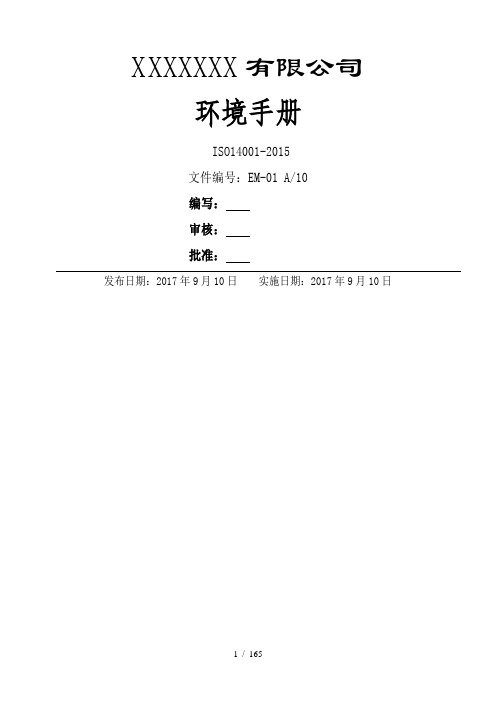
XXXXXXX有限公司环境手册ISO14001-2015文件编号:EM-01 A/10编写:审核:批准:发布日期:2017年9月10日实施日期:2017年9月10日修订记录目录第1 章概述1.1 颁布令1.2 公司简介1.3 管理者代表任命书1.4 环境手册的管理第2章管理体系范围第3章手册引用文件、术语和定义3.1 引用标准文件3.2 术语和定义第4章组织的背景4.1理解组织及其所处的环境4.2 理解相关方的需求和期望4.3确定管理体系的范围4.4管理体系及其过程第5章领导作用5.1 领导和承诺5.2 环境方针5.3 组织的岗位、职责和权限第6章质量环境管理体系策划6.1 应对风险和机遇的措施6.1.1 总则6.1.2 环境因素6.1.3 合规义务6.1.4 措施的策划6.2 环境目标及其实现策划6.2.1 环境目标6.2.2 实现环境目标措施的策划第7章支持7.1 资源7.2 能力7.3 意识7.4 信息交流7.4.1 总则7.4.2 内部信息交流7.4.3 外部信息交流7.5 文件信息7.5.1 总则7.5.2 创建和更新7.5.3 文件信息控制第8章运作8.1 运行策划和控制8.2 应急准备和响应第9章绩效评价9.1 监视、测量、分析和评价9.1.1 总则9.1.2 合规性评价9.2 内部审核9.2.1 总则9.2.2 内部审核方案9.3 管理评审第10章改进10.1 总则10.2 不符合和纠正措施10.3 持续改进1.1环境手册颁布令环境手册是本公司从事与环境管理有关的活动中必须共同遵守的纲领性文件,是公司的基本法规之一,必须严格遵守,以确保公司环境管理体系的正常运行,实现质量环境管理目标,促使公司环境管理工作得到持续改进与不断发展。
环境手册由管理者代表负责组织编写、并经总经理批准发布,是我公司环境管理工作的法规性、纲领性文件,用以统一、协调全公司的质量环境管理活动,使其基于ISO14001-2015标准要求,符合本公司产品、服务和活动中的实际情况,能指导我公司环境管理工作。
环境管理体系ISO 14001:2015新版标准正式发布

龙源期刊网
环境管理体系ISO 14001:2015新版标准正式发布
作者:
来源:《WTO经济导刊》2015年第10期
ISO 14001作为世界上首个被广泛采用的环境管理体系国际标准,现已帮助全球超过300,000家组织提升其环境绩效。
目前,该标准经过了自1996年正式发布以来的首次重大改版,新版标准已于9月15日正式发布。
新版标准可确保其能够继续帮助组织改进业务流程、节约成本和应对未来的环境挑战。
来自70多个国家/地区的环境专家参与了本次改版,改版后的标准融入了一系列更新内容,旨在帮助组织处理不断变化的业务状况——从气候变化到供应链管理。
ISO 14001 2015版标准
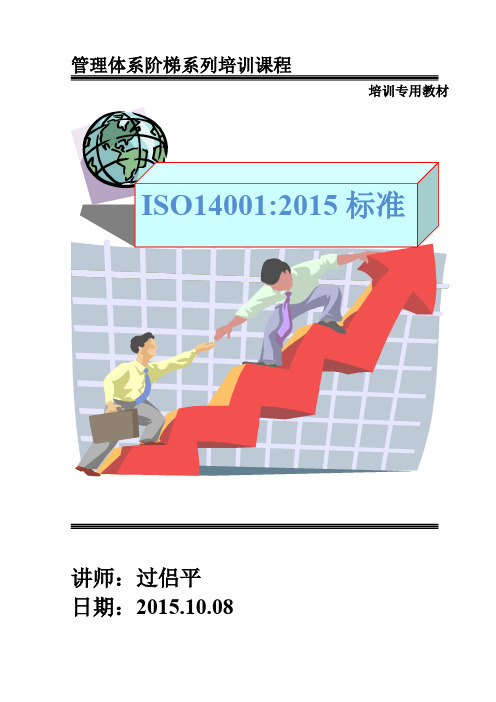
管理体系阶梯系列培训课程培训专用教材讲师:过侣平日期:2015.10.08培训专用教材 ISO14001标准Page 1环境管理体系——要求及使用指南1 范围本国际标准规定了环境管理体系的要求,一个组织可以使用以提高其环境绩效。
本国际标准使 一个组织可以寻求系统化管理其环境责任,以有助于可持续发展的环境支柱的方式。
本国际标准帮助组织获得其环境管理体系的输出,提供组织自身和相关方的环境价值,与本组织的环境方针相一致,环境管理体系预期的输出包括:—提高环境绩效;—履行合规性义务;—实现环境目标。
本标准适用于任何组织,不论大小、类型和性质,适用于本组织的活动、产品和服务的环境因素,从一个生命周期的角度考虑组织确定它能够控制或影响。
这个国际标准不规定具体的环境绩效准则。
这一国际标准可用于整体或部分系统化地改进环境管理。
然而,声称符合本国际标准的要求是不能接受的,除非所有的要求被纳入一个组织的环境管理体系和没有删减。
2 规范性引用文件没有规范性引用。
3 术语和定义为本文件的目的,下列术语和定义适用。
3.1与组织和领导有关的术语3.1.1管理体系组织的一组相互关联或相互作用的要素(3.1.4)以建立方针和目标(3.2.5)和过程(3.3.5)以实现这些目标。
注1:一个管理体系可以包括一个领域或几个领域(如质量,环境,职业健康与安全,能源,财务管理)。
附注2:体系要素包括组织结构、角色和职责、策划与运行、绩效评价及改进。
附注3:一个管理体系的范围可以包括整个组织,规定或指定的组织的职能,规定或指定的部分的组织,或一个或多个横跨组织团体的职能。
3.1.2环境管理体系管理体系的一部分(3.1.1)用于管理环境因素(3.2.2),履行合规性义务(3.2.9),和处理风险和机会(3.2.11)3.1.3环境方针由最高管理者(3.1.5)正式发布的相关环境绩效(3.4.11)的一个组织(3.1.4)的意图和方向。
培训专用教材·ISO14001标准3.1.4组织为了实现其目标(3.2.5)有自己的职能和职责、权限和关系的人或群体。
ISO140012015版标准
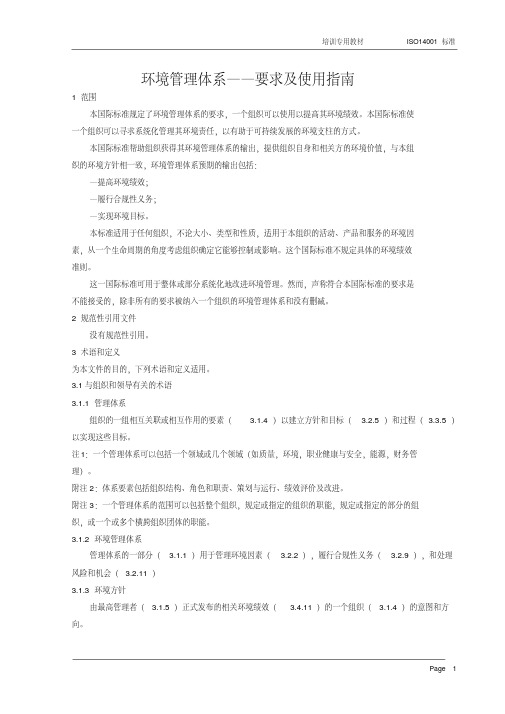
环境管理体系——要求及使用指南1 范围本国际标准规定了环境管理体系的要求,一个组织可以使用以提高其环境绩效。
本国际标准使一个组织可以寻求系统化管理其环境责任,以有助于可持续发展的环境支柱的方式。
本国际标准帮助组织获得其环境管理体系的输出,提供组织自身和相关方的环境价值,与本组织的环境方针相一致,环境管理体系预期的输出包括:—提高环境绩效;—履行合规性义务;—实现环境目标。
本标准适用于任何组织,不论大小、类型和性质,适用于本组织的活动、产品和服务的环境因素,从一个生命周期的角度考虑组织确定它能够控制或影响。
这个国际标准不规定具体的环境绩效准则。
这一国际标准可用于整体或部分系统化地改进环境管理。
然而,声称符合本国际标准的要求是不能接受的,除非所有的要求被纳入一个组织的环境管理体系和没有删减。
2 规范性引用文件没有规范性引用。
3 术语和定义为本文件的目的,下列术语和定义适用。
3.1与组织和领导有关的术语3.1.1管理体系组织的一组相互关联或相互作用的要素( 3.1.4)以建立方针和目标( 3.2.5)和过程( 3.3.5)以实现这些目标。
注1:一个管理体系可以包括一个领域或几个领域(如质量,环境,职业健康与安全,能源,财务管理)。
附注2:体系要素包括组织结构、角色和职责、策划与运行、绩效评价及改进。
附注3:一个管理体系的范围可以包括整个组织,规定或指定的组织的职能,规定或指定的部分的组织,或一个或多个横跨组织团体的职能。
3.1.2环境管理体系管理体系的一部分( 3.1.1)用于管理环境因素( 3.2.2),履行合规性义务( 3.2.9),和处理风险和机会( 3.2.11)3.1.3环境方针由最高管理者( 3.1.5)正式发布的相关环境绩效( 3.4.11)的一个组织( 3.1.4)的意图和方向。
3.1.4组织为了实现其目标( 3.2.5)有自己的职能和职责、权限和关系的人或群体。
注1:组织的概念包括但不局限于单一的贸易商,公司,社团,企业,当权者,合伙企业,慈善机关或事业单位,或部分或组合,是否股份制或不是,公共的或私有的。
ISO_14001_2015(en)-新环境管理体系标准

© ISO 2015Environmental management systems — Requirements with guidance for useSystèmes de management environnemental — Exigences et lignes directrices pour son utilisationINTERNATIONAL STANDARD ISO 14001Third edition 2015-09-15Reference number ISO 14001:2015(E)ISO 14001:2015(E)ii © ISO 2015 – All rights reservedCOPYRIGHT PROTECTED DOCUMENT© ISO 2015, Published in Switzerland All rights reserved. Unless otherwise specified, no part of this publication may be reproduced or utilized otherwise in any form or by any means, electronic or mechanical, including photocopying, or posting on the internet or an intranet, without prior written permission. Permission can be requested from either ISO at the address below or ISO’s member body in the country of the requester.ISO copyright office Ch. de Blandonnet 8 • CP 401CH-1214 Vernier, Geneva, Switzerland Tel. +41 22 749 01 11Fax +41 22 749 09 47copyright@ISO 14001:2015(E)Contents Page Foreword (v)Introduction (vi)1 Scope (1)2 Normative references (1)3 Terms and definitions (1)3.1 Terms related to organization and leadership (1)3.2 Terms related to planning (2)3.3 Terms related to support and operation (4)3.4 Terms related to performance evaluation and improvement (5)4 Context of the organization (6)4.1 Understanding the organization and its context (6)4.2 Understanding the needs and expectations of interested parties (6)4.3 Determining the scope of the environmental management system (6)4.4 Environmental management system (7)5 Leadership (7)5.1 Leadership and commitment (7)5.2 Environmental policy (7)5.3 Organizational roles, responsibilities and authorities (8)6 Planning (8)6.1 Actions to address risks and opportunities (8)6.1.1 General (8)6.1.2 Environmental aspects (9)6.1.3 Compliance obligations (9)6.1.4 Planning action (9)6.2 Environmental objectives and planning to achieve them (10)6.2.1 Environmental objectives (10)6.2.2 Planning actions to achieve environmental objectives (10)7 Support (10)7.1 Resources (10)7.2 Competence (11)7.3 Awareness (11)7.4 Communication (11)7.4.1 General (11)7.4.2 Internal communication (12)7.4.3 External communication (12)7.5 Documented information (12)7.5.1 General (12)7.5.2 Creating and updating (12)7.5.3 Control of documented information (12)8 Operation (13)8.1 Operational planning and control (13)8.2 Emergency preparedness and response (13)9 Performance evaluation (14)9.1 Monitoring, measurement, analysis and evaluation (14)9.1.1 General (14)9.1.2 Evaluation of compliance (14)9.2 Internal audit (15)9.2.1 General (15)9.2.2 Internal audit programme (15)9.3 Management review (15)© ISO 2015 – All rights reserved iiiISO 14001:2015(E)10 Improvement (16)10.1 General (16)10.2 Nonconformity and corrective action (16)10.3 Continual improvement (17)Annex A (informative) Guidance on the use of this International Standard (18)Annex B (informative) Correspondence between ISO 14001:2015 and ISO 14001:2004 (32)Bibliography (34)Alphabetical index of terms (35)iv© ISO 2015 – All rights reservedISO 14001:2015(E)ForewordISO (the International Organization for Standardization) is a worldwide federation of national standards bodies (ISO member bodies). The work of preparing International Standards is normally carried out through ISO technical committees. Each member body interested in a subject for which a technical committee has been established has the right to be represented on that committee. International organizations, governmental and non-governmental, in liaison with ISO, also take part in the work. ISO collaborates closely with the International Electrotechnical Commission (IEC) on all matters of electrotechnical standardization.The procedures used to develop this document and those intended for its further maintenance are described in the ISO/IEC Directives, Part 1. In particular the different approval criteria needed for the different types of ISO documents should be noted. This document was drafted in accordance with the editorial rules of the ISO/IEC Directives, Part 2 (see /directives). Attention is drawn to the possibility that some of the elements of this document may be the subject of patent rights. ISO shall not be held responsible for identifying any or all such patent rights. Details of any patent rights identified during the development of the document will be in the Introduction and/or on the ISO list of patent declarations received (see /patents).Any trade name used in this document is information given for the convenience of users and does not constitute an endorsement.For an explanation on the meaning of ISO specific terms and expressions related to conformity assessment, as well as information about ISO’s adherence to the World Trade Organization (WTO) principles in the Technical Barriers to Trade (TBT) see the following URL: /iso/foreword.html. The committee responsible for this document is Technical Committee ISO/TC 207, Environmental management, Subcommittee SC 1, Environmental management systems.This third edition cancels and replaces the second edition (ISO 14001:2004), which has been technically revised. It also incorporates the Technical Corrigendum ISO 14001:2004/Cor.1:2009.© ISO 2015 – All rights reserved vISO 14001:2015(E)Introduction0.1 BackgroundAchieving a balance between the environment, society and the economy is considered essential to meet the needs of the present without compromising the ability of future generations to meet their needs. Sustainable development as a goal is achieved by balancing the three pillars of sustainability. Societal expectations for sustainable development, transparency and accountability have evolved with increasingly stringent legislation, growing pressures on the environment from pollution, inefficient use of resources, improper waste management, climate change, degradation of ecosystems and loss of biodiversity.This has led organizations to adopt a systematic approach to environmental management by implementing environmental management systems with the aim of contributing to the environmental pillar of sustainability.0.2 Aim of an environmental management systemThe purpose of this International Standard is to provide organizations with a framework to protect the environment and respond to changing environmental conditions in balance with socio-economic needs. It specifies requirements that enable an organization to achieve the intended outcomes it sets for its environmental management system.A systematic approach to environmental management can provide top management with information to build success over the long term and create options for contributing to sustainable development by:— protecting the environment by preventing or mitigating adverse environmental impacts;— mitigating the potential adverse effect of environmental conditions on the organization;— assisting the organization in the fulfilment of compliance obligations;— enhancing environmental performance;— controlling or influencing the way the organization’s products and services are designed, manufactured, distributed, consumed and disposed by using a life cycle perspective that can prevent environmental impacts from being unintentionally shifted elsewhere within the life cycle;— achieving financial and operational benefits that can result from implementing environmentally sound alternatives that strengthen the organization’s market position;— communicating environmental information to relevant interested parties.This International Standard, like other International Standards, is not intended to increase or change an organization’s legal requirements.0.3 Success factorsThe success of an environmental management system depends on commitment from all levels and functions of the organization, led by top management. Organizations can leverage opportunities to prevent or mitigate adverse environmental impacts and enhance beneficial environmental impacts, particularly those with strategic and competitive implications. Top management can effectively address its risks and opportunities by integrating environmental management into the organization’s business processes, strategic direction and decision making, aligning them with other business priorities, and incorporating environmental governance into its overall management system. Demonstration of successful implementation of this International Standard can be used to assure interested parties that an effective environmental management system is in place.Adoption of this International Standard, however, will not in itself guarantee optimal environmental outcomes. Application of this International Standard can differ from one organization to anothervi© ISO 2015 – All rights reservedISO 14001:2015(E)due to the context of the organization. Two organizations can carry out similar activities but can have different compliance obligations, commitments in their environmental policy, environmental technologies and environmental performance goals, yet both can conform to the requirements of this International Standard.The level of detail and complexity of the environmental management system will vary depending on the context of the organization, the scope of its environmental management system, its compliance obligations, and the nature of its activities, products and services, including its environmental aspects and associated environmental impacts.0.4 Plan-Do-Check-Act modelThe basis for the approach underlying an environmental management system is founded on the concept of Plan-Do-Check-Act (PDCA). The PDCA model provides an iterative process used by organizations to achieve continual improvement. It can be applied to an environmental management system and to each of its individual elements. It can be briefly described as follows.— Plan: establish environmental objectives and processes necessary to deliver results in accordance with the organization’s environmental policy.— Do: implement the processes as planned.— Check: monitor and measure processes against the environmental policy, including its commitments, environmental objectives and operating criteria, and report the results.— Act: take actions to continually improve.Figure 1 shows how the framework introduced in this International Standard could be integrated into aFigure 1 — Relationship between PDCA and the framework in this International Standard 0.5 Contents of this International StandardThis International Standard conforms to ISO’s requirements for management system standards. These requirements include a high level structure, identical core text, and common terms with core definitions, designed to benefit users implementing multiple ISO management system standards.© ISO 2015 – All rights reserved viiISO 14001:2015(E)This International Standard does not include requirements specific to other management systems, such as those for quality, occupational health and safety, energy or financial management. However, this International Standard enables an organization to use a common approach and risk-based thinking to integrate its environmental management system with the requirements of other management systems. This International Standard contains the requirements used to assess conformity. An organization that wishes to demonstrate conformity with this International Standard can do so by:— making a self-determination and self-declaration, or— seeking confirmation of its conformance by parties having an interest in the organization, such as customers, or— seeking confirmation of its self-declaration by a party external to the organization, or — seeking certification/registration of its environmental management system by an external organization.Annex A provides explanatory information to prevent misinterpretation of the requirements of this International Standard. Annex B shows broad technical correspondence between the previous edition of this International Standard and this edition. Implementation guidance on environmental management systems is included in ISO 14004.In this International Standard, the following verbal forms are used:— “shall” indicates a requirement;— “should” indicates a recommendation;— “may” indicates a permission;— “can” indicates a possibility or a capability.Information marked as “NOTE” is intended to assist the understanding or use of the document. “Notes to entry” used in Clause 3 provide additional information that supplements the terminological data and can contain provisions relating to the use of a term.The terms and definitions in Clause 3 are arranged in conceptual order, with an alphabetical index provided at the end of the document.viii© ISO 2015 – All rights reservedEnvironmental management systems — Requirements with guidance for use1 ScopeThis International Standard specifies the requirements for an environmental management system that an organization can use to enhance its environmental performance. This International Standard is intended for use by an organization seeking to manage its environmental responsibilities in a systematic manner that contributes to the environmental pillar of sustainability.This International Standard helps an organization achieve the intended outcomes of its environmental management system, which provide value for the environment, the organization itself and interested parties. Consistent with the organization’s environmental policy, the intended outcomes of an environmental management system include:— enhancement of environmental performance;— fulfilment of compliance obligations;— achievement of environmental objectives.This International Standard is applicable to any organization, regardless of size, type and nature, and applies to the environmental aspects of its activities, products and services that the organization determines it can either control or influence considering a life cycle perspective. This International Standard does not state specific environmental performance criteria.This International Standard can be used in whole or in part to systematically improve environmental management. Claims of conformity to this International Standard, however, are not acceptable unless all its requirements are incorporated into an organization’s environmental management system and fulfilled without exclusion.2 Normative referencesThere are no normative references.3 Terms and definitionsFor the purposes of this document, the following terms and definitions apply.3.1 Terms related to organization and leadership3.1.1management system set of interrelated or interacting elements of an organization (3.1.4) to establish policies and objectives (3.2.5) and processes (3.3.5) to achieve those objectivesNote 1 to entry: A management system can address a single discipline or several disciplines (e.g. quality, environment, occupational health and safety, energy, financial management).Note 2 to entry: The system elements include the organization’s structure, roles and responsibilities, planning and operation, performance evaluation and improvement.Note 3 to entry: The scope of a management system can include the whole of the organization, specific and identified functions of the organization, specific and identified sections of the organization, or one or more functions across a group of organizations.INTERNATIONAL STANDARD ISO 14001:2015(E)© ISO 2015 – All rights reserved 1ISO 14001:2015(E)3.1.2environmental management systempart of the management system (3.1.1) used to manage environmental aspects (3.2.2), fulfil compliance obligations (3.2.9), and address risks and opportunities (3.2.11)3.1.3environmental policyintentions and direction of an organization (3.1.4) related to environmental performance (3.4.11), as formally expressed by its top management (3.1.5)3.1.4organizationperson or group of people that has its own functions with responsibilities, authorities and relationships to achieve its objectives (3.2.5)Note 1 to entry: The concept of organization includes, but is not limited to sole-trader, company, corporation, firm, enterprise, authority, partnership, charity or institution, or part or combination thereof, whether incorporated or not, public or private.3.1.5top managementperson or group of people who directs and controls an organization (3.1.4) at the highest levelNote 1 to entry: Top management has the power to delegate authority and provide resources within the organization.Note 2 to entry: If the scope of the management system (3.1.1) covers only part of an organization, then top management refers to those who direct and control that part of the organization.3.1.6interested partyperson or organization (3.1.4) that can affect, be affected by, or perceive itself to be affected by a decision or activityEXAMPLE Customers, communities, suppliers, regulators, non-governmental organizations, investors and employees.Note 1 to entry: To “perceive itself to be affected” means the perception has been made known to the organization.3.2 Terms related to planning3.2.1environmentsurroundings in which an organization (3.1.4) operates, including air, water, land, natural resources, flora, fauna, humans and their interrelationshipsNote 1 to entry: Surroundings can extend from within an organization to the local, regional and global system. Note 2 to entry: Surroundings can be described in terms of biodiversity, ecosystems, climate or other characteristics.3.2.2environmental aspectelement of an organization’s (3.1.4) activities or products or services that interacts or can interact with the environment (3.2.1)Note 1 to entry: An environmental aspect can cause (an) environmental impact(s) (3.2.4). A significant environmental aspect is one that has or can have one or more significant environmental impact(s). Note 2 to entry: Significant environmental aspects are determined by the organization applying one or more criteria.2 © ISO 2015 – All rights reserved3.2.3environmental conditionstate or characteristic of the environment (3.2.1) as determined at a certain point in time3.2.4environmental impactchange to the environment (3.2.1), whether adverse or beneficial, wholly or partially resulting from an organization’s (3.1.4) environmental aspects (3.2.2)3.2.5objectiveresult to be achievedNote 1 to entry: An objective can be strategic, tactical, or operational.Note 2 to entry: Objectives can relate to different disciplines (such as financial, health and safety, and environmental goals) and can apply at different levels (such as strategic, organization-wide, project, product, service and process (3.3.5)).Note 3 to entry: An objective can be expressed in other ways, e.g. as an intended outcome, a purpose, an operational criterion, as an environmental objective (3.2.6), or by the use of other words with similar meaning(e.g. aim, goal, or target).3.2.6environmental objectiveobjective (3.2.5) set by the organization (3.1.4) consistent with its environmental policy (3.1.3)3.2.7prevention of pollutionuse of processes (3.3.5), practices, techniques, materials, products, services or energy to avoid, reduce or control (separately or in combination) the creation, emission or discharge of any type of pollutant or waste, in order to reduce adverse environmental impacts (3.2.4)Note 1 to entry: Prevention of pollution can include source reduction or elimination; process, product or service changes; efficient use of resources; material and energy substitution; reuse; recovery; recycling, reclamation; or treatment.3.2.8requirementneed or expectation that is stated, generally implied or obligatoryNote 1 to entry: “Generally implied” means that it is custom or common practice for the organization (3.1.4) and interested parties (3.1.6) that the need or expectation under consideration is implied.Note 2 to entry: A specified requirement is one that is stated, for example in documented information (3.3.2). Note 3 to entry: Requirements other than legal requirements become obligatory when the organization decides to comply with them.3.2.9compliance obligations (preferred term)legal requirements and other requirements (admitted term)legal requirements (3.2.8) that an organization (3.1.4) has to comply with and other requirements that an organization has to or chooses to comply withNote 1 to entry: Compliance obligations are related to the environmental management system (3.1.2). Note 2 to entry: Compliance obligations can arise from mandatory requirements, such as applicable laws and regulations, or voluntary commitments, such as organizational and industry standards, contractual relationships, codes of practice and agreements with community groups or non-governmental organizations.© ISO 2015 – All rights reserved 33.2.10riskeffect of uncertaintyNote 1 to entry: An effect is a deviation from the expected — positive or negative.Note 2 to entry: Uncertainty is the state, even partial, of deficiency of information related to, understanding or knowledge of, an event, its consequence, or likelihood.Note 3 to entry: Risk is often characterized by reference to potential “events” (as defined in ISO Guide 73:2009, 3.5.1.3) and “consequences” (as defined in ISO Guide 73:2009, 3.6.1.3), or a combination of these. Note 4 to entry: Risk is often expressed in terms of a combination of the consequences of an event (including changes in circumstances) and the associated “likelihood” (as defined in ISO Guide 73:2009, 3.6.1.1) of occurrence.3.2.11risks and opportunitiespotential adverse effects (threats) and potential beneficial effects (opportunities)3.3 Terms related to support and operation3.3.1competenceability to apply knowledge and skills to achieve intended results3.3.2documented informationinformation required to be controlled and maintained by an organization (3.1.4) and the medium on which it is containedNote 1 to entry: Documented information can be in any format and media, and from any source. Note 2 to entry: Documented information can refer to:— the environmental management system (3.1.2), including related processes (3.3.5);— information created in order for the organization to operate (can be referred to as documentation);— evidence of results achieved (can be referred to as records).3.3.3life cycleconsecutive and interlinked stages of a product (or service) system, from raw material acquisition or generation from natural resources to final disposalNote 1 to entry: The life cycle stages include acquisition of raw materials, design, production, transportation/ delivery, use, end-of-life treatment and final disposal.[SOURCE: ISO 14044:2006, 3.1, modified ― The words “(or service)” have been added to the definition and Note 1 to entry has been added.]3.3.4outsource (verb)make an arrangement where an external organization (3.1.4) performs part of an organization’s function or process (3.3.5)Note 1 to entry: An external organization is outside the scope of the management system (3.1.1), although the outsourced function or process is within the scope.4 © ISO 2015 – All rights reserved3.3.5processset of interrelated or interacting activities which transforms inputs into outputsNote 1 to entry: A process can be documented or not.3.4 Terms related to performance evaluation and improvement3.4.1auditsystematic, independent and documented process (3.3.5) for obtaining audit evidence and evaluating it objectively to determine the extent to which the audit criteria are fulfilledNote 1 to entry: An internal audit is conducted by the organization (3.1.4) itself, or by an external party on its behalf. Note 2 to entry: An audit can be a combined audit (combining two or more disciplines).Note 3 to entry: Independence can be demonstrated by the freedom from responsibility for the activity being audited or freedom from bias and conflict of interest.Note 4 to entry: “Audit evidence” consists of records, statements of fact or other information which are relevant to the audit criteria and are verifiable; and “audit criteria” are the set of policies, procedures or requirements (3.2.8) used as a reference against which audit evidence is compared, as defined in ISO 19011:2011, 3.3 and 3.2 respectively.3.4.2conformityfulfilment of a requirement (3.2.8)3.4.3nonconformitynon-fulfilment of a requirement (3.2.8)Note 1 to entry: Nonconformity relates to requirements in this International Standard and additional environmental management system (3.1.2) requirements that an organization (3.1.4) establishes for itself.3.4.4corrective actionaction to eliminate the cause of a nonconformity (3.4.3) and to prevent recurrenceNote 1 to entry: There can be more than one cause for a nonconformity.3.4.5continual improvementrecurring activity to enhance performance (3.4.10)Note 1 to entry: Enhancing performance relates to the use of the environmental management system (3.1.2) to enhance environmental performance (3.4.11) consistent with the organization’s (3.1.4) environmental policy (3.1.3). Note 2 to entry: The activity need not take place in all areas simultaneously, or without interruption.3.4.6effectivenessextent to which planned activities are realized and planned results achieved3.4.7indicatormeasurable representation of the condition or status of operations, management or conditions [SOURCE: ISO 14031:2013, 3.15]© ISO 2015 – All rights reserved 53.4.8monitoringdetermining the status of a system, a process (3.3.5) or an activityNote 1 to entry: To determine the status, there might be a need to check, supervise or critically observe.3.4.9measurementprocess (3.3.5) to determine a value3.4.10performancemeasurable resultNote 1 to entry: Performance can relate either to quantitative or qualitative findings.Note 2 to entry: Performance can relate to the management of activities, processes (3.3.5), products (including services), systems or organizations (3.1.4).3.4.11environmental performanceperformance (3.4.10) related to the management of environmental aspects (3.2.2)Note 1 to entry: For an environmental management system (3.1.2), results can be measured against the organization’s (3.1.4) environmental policy (3.1.3), environmental objectives (3.2.6) or other criteria, using indicators (3.4.7).4 Context of the organization4.1 Understanding the organization and its contextThe organization shall determine external and internal issues that are relevant to its purpose and that affect its ability to achieve the intended outcomes of its environmental management system. Such issues shall include environmental conditions being affected by or capable of affecting the organization.4.2 Understanding the needs and expectations of interested partiesThe organization shall determine:a) the interested parties that are relevant to the environmental management system;b) the relevant needs and expectations (i.e. requirements) of these interested parties;c) which of these needs and expectations become its compliance obligations.4.3 Determining the scope of the environmental management systemThe organization shall determine the boundaries and applicability of the environmental management system to establish its scope.When determining this scope, the organization shall consider:a) the external and internal issues referred to in 4.1;b) the compliance obligations referred to in 4.2;c) its organizational units, functions and physical boundaries;d) its activities, products and services;e) its authority and ability to exercise control and influence.6 © ISO 2015 – All rights reserved。
- 1、下载文档前请自行甄别文档内容的完整性,平台不提供额外的编辑、内容补充、找答案等附加服务。
- 2、"仅部分预览"的文档,不可在线预览部分如存在完整性等问题,可反馈申请退款(可完整预览的文档不适用该条件!)。
- 3、如文档侵犯您的权益,请联系客服反馈,我们会尽快为您处理(人工客服工作时间:9:00-18:30)。
ISO 14001作为世界上首个被广泛采用的环境管理体系国际标准,现已帮助全球超过300,000 家组织提升其环境绩效。
目前,该标准经过了自1996年正式发布以来的首次重大改版,新版标准已于昨日(9月15日)正式发布。
新版标准可确保其能够继续帮助组织改进业务流程、节约成本和应对未来的环境挑战。
来自70 多个国家/地区的环境专家参与了本次改版,改版后的标准融入了一系列更新内容,旨在帮助组织处理不断变化的业务状况——从气候变化到供应链管理。
ISO 14001为组织提供了一个框架,使其能够在业务不断发展增长的同时,降低对环境的影响、减少浪费、节约能源。
ISO 14001还能帮助企业更具创新性、改进管理体系流程、满足相关法规要求、增强企业在投资者、客户和公众眼中的信誉度。
最终,这一新标准将帮助企业与环境领域的变化保持同步,确保其始终处于领先地位。
ISO 14001:2015 的变更包括
1、新的高阶结构(HLS)采用所有管理体系标准通用的术语、定义、标题和正文,以便在实施多个管理体系时实现轻松整合
2、对于高级管理层而言,是进一步确保将环境管理纳入核心业务流程和目标的新机会
3、重新聚焦组织面临的风险(例如:原材料的价格波动)和这些风险所带来的机遇(更高的资源能效)
4、对组织环境的新思考,帮助他们了解所处环境以及对环境的影响,同时还要了解环境问题(例如:气候变化)对企业自身的影响。
ISO 14001:2015标准换版时间轴
1、2014年7月
ISO 14001:2015 DIS版发布
2、2014年12月
ISO国际标准化组织正式投票通过ISO 14001:2015 DIS版,新标准进入FDIS 阶段
3、2015年4月
ISO 14001:2015更新关键会议在英国召开,负责ISO 14001修订的ISO 技术委员会ISO/TC 207/WG 5 表示,他们在此次会议上朝着ISO 14001:2015的发布迈出了意义重大的一步。
4、2015年5月
ISO 14001:2015 FDIS版本投票通过
5、2015年9月
ISO 14001:2015于9月15日正式发布。
